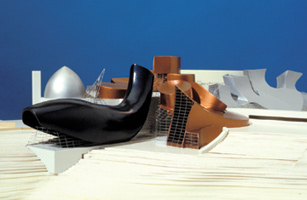
STYLE TRIAL: Model for the Peter Lewis House
All good artists find inspiration where they can — even if that means tapping failure. In 1985, Pritzker Prize-winning architect Frank Gehry was commissioned to design a home for Ohio insurance magnate Peter Lewis. The project began well: Gehry was encouraged to experiment and push the boundaries in form and function. His breakthroughs would end up as crucial elements in later designs, including some that changed the course of architecture. The otherworldly Guggenheim Bilbao in Spain or the ethereal Walt Disney Concert Hall in Los Angeles would not exist without the organic renderings of the Lewis House, a building that during its gestation varied in appearance from boat to octopus to whale.
Now, in "Frank O. Gehry: Design Process and the Lewis House" (running until April 5, 2009), the Philadelphia Museum of Art takes on this decade-long project with a new appreciation of its lasting effect. The show includes 120 hand-built models, photographs, bentwood Knoll furniture prototypes, decorative objects and footage from A Constructive Madness, a 2003 documentary about the project. Together, the models, drawings and video help to track Gehry's creative evolution, showing the seeds of the warped style for which he's so well known today. "You see a similar use of materials and forms in the Lewis House models and in all of the work shown in the exhibition," says curator Kathryn Hiesinger, the show's mastermind.
While it celebrates what came later, the exhibition is also a tribute to what never was. After Lewis had funneled nearly $82 million into the project, it was abandoned due to rising costs and lack of final planning approval. Gehry had to walk away. But what he left behind is remarkable.